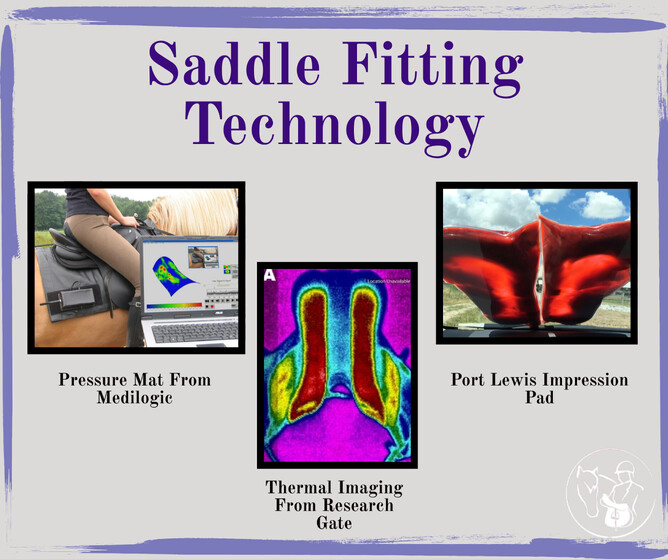Saddle Fitting has been around as long as saddles have been used on horses. Surprised? Don't be, it wasn't really horse welfare that created the need for it, but because horses were used for warfare, and sore slow horses had a negative outcome for the riders, there was a human survival need for it.
Not so long ago, mounted cavalry were all trained in the basics of saddle fit because they found that as the miles increased the horses would lose condition and needed support to rebalance their saddles and stay comfortable and sound. This was relatively crude, but effective with rebalancing coming from adjusting the way towels were folded and placed under the saddles.
Skip forward to our modern life, saddle fitting has become a separate field of employment, with most branching off from Saddlers (who make saddles, bridles, harnesses and really anything from leather, and who used to always be fitters as well).
So let's start with how we generally fit a saddle on a daily basis:
An information session is carried out gathering information about the horses current fitness, shape, age, history of injury, plans for the short term and medium term, and any issues that could make the horse and rider asymmetrical, and observations of the horse moving without a rider.
A template is taken of the horses shape under the saddle area.
A physical static check of the existing saddle is done, using visual assessment and touch to feel for even and appropriate contact/ pressure.
A ridden assessment to observe the horse in motion, the riders balance, any movement in the saddle and the overall feel of the horse/saddle/ rider combination.
The above ridden assessment may be done several times if the saddle is having adjustments made to it.
When everything is going well, no one questions the "simplicity' of the fitting technique, but when problems arise, it's often asked why we don't use more tools to ensure a better fit.
What other tools are there?
PRESSURE MATS
These are used under the saddles to measure pressure from the rider coming down on the saddle, and the horse up into the saddle, and capture the dynamic changes seen between the horse/ saddle/ rider in various gaits/ jumping etc.
Pros:
Good at giving pressure feed back from up and down pressure, and are able to show where we have high area's of pressure taken under the saddle, for how long and can having live recordings to see how/ when the pressure changes during the ride.
Con's:
They are not yet able to tell us WHY we have high area's of pressure, so we must have a skilled interpreter to look at the results to understand what pressure is from the saddle, what is from rider, and what is normal.
There is a newly recognised 'shear' force under saddle which isn't able to be recorded yet (which is the forward and back movement we see) but can be observed with the eye quite easily at canter. This is thought to have a bit to do with saddle movement and fit/ comfort issues.
The riders position/ movement can skew the results, showing more pressure if the rider is unbalanced, asymmetrical or doesn't fit into the saddle well..
Cost and time. These good pressure mats cost tens of thousands, so you can expect your fitting to take more time and money.
THERMAL IMAGING
These have been used to look at the heat signatures under the saddle with the thought being that the hotter the area under the saddle the more pressure is taken under that area.
Pro's:
More easily available to find/ use than pressure mats.
Can give insight if we see high areas of circulation issues with muscle atrophy/ inflammation under a saddle.
Con's:
The new research from 2021 has shown that thermal imaging alone isn't reliable in showing increased peak forces. https://beva.onlinelibrary.wiley.com/.../evj.16_13492...
PORT LEWIS IMPRESSION PAD
This is a pad filled with a playdough like substance which is designed to sit under your saddle and high pressure area's will show up as thinner parts on the pad.
Pro's:
Good at giving pressure feedback from up and down pressure, and are able to show where we have high area's of pressure taken under the saddle.
Cheap to use in comparison to other technologies.
Isn't affected by weather temperatures.
Can be reused multiple times
Con's:
You need to understand how your saddle fits to start with for the results to have any meaning.
They are not able to tell us why we have high area's of pressure, so we must have a skilled interpreter to look at the results to understand what is saddle, what is rider, and what is normal.
The impression can't tell you why you have any asymmetries on your pad or how to resolve them.
Must be put on correctly or the imprints will be misleading, including getting on from a mounting block.
We also have some slightly less technical tools like sweat patterns and chalk dust impressions which provide some insight into the fit once we have evaluated the saddle/ horse/ rider combination.
So what is the take home message?
Using more advanced saddle fitting technologies have a very important role in research, but unlike in clinical trials, the variables in day to day fittings are rarely able to be kept the same between horses/ riders (especially in NZ where we have very limited access to indoor arena's), and so answers based solely on the technology can be misleading, expensive and difficult to interpret.
While it is not perfect, or unbiased, a good understanding of saddle tree shapes, panel shapes, potential biomechanical issues with the horse and rider do provide a lot of insight into fitting issues. The difference between a well fitting saddle and a saddle causing discomfort could be as simple as the horse dropping 40kg's.
The saddle fitters role should be part of a bigger team, with a basic understanding of rider and horse biomechanics to make sure when issues are occurring, that we have a good team around us to help resolve the issues when a saddle adjustment alone isn't resolving the issue.
And most of all - with all the tools in the world, the most important part of fitting is communication with your saddle fitter when things aren't going as they should. And of course every saddle fitter is waiting for the day the technology is there to simply stick a pad under every saddle to make sure what we are seeing/ feeling is what is happening for the horse & rider so we don't have to second guess ourselves!
What are the key steps in a saddle fitting session?
A saddle fitting session involves assessing the horse and rider, taking a template of the horse’s shape, evaluating the saddle’s static fit, and observing its performance during ridden movement.
What tools are commonly used in saddle fitting?
Advanced tools like pressure mats, thermal imaging, and impression pads are used to analyse saddle fit, but expert interpretation remains crucial.
How do I know if my saddle needs adjusting?
Signs such as your horse’s discomfort, behavioral changes, or visible saddle movement may indicate the need for a fitting adjustment.





